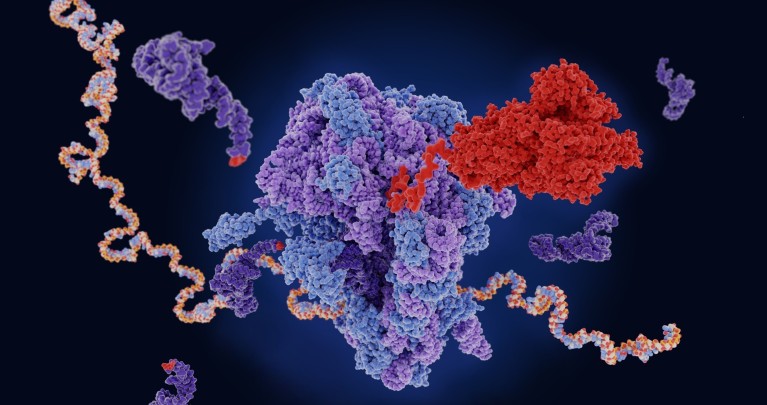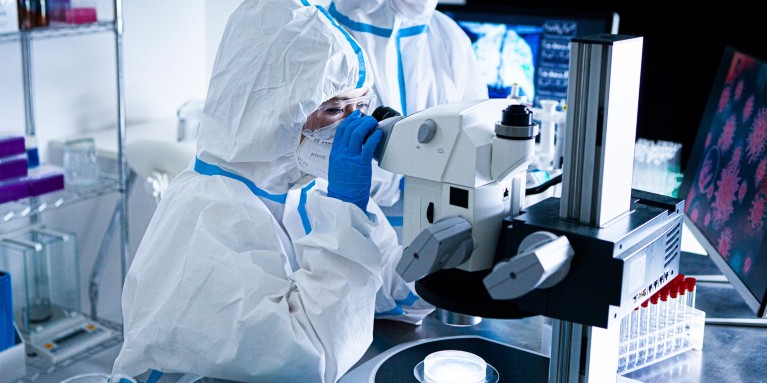The COVID-19 pandemic has triggered an unprecedented mobilization of resources to find vaccines and therapeutics to treat and prevent infection with SARS-CoV-2. mRNA technology was quickly adopted in the COVID-19 vaccine race and has undoubtedly proven its worth.

mRNA vaccines use the host cell to generate the SARS-CoV-2 spike protein. Credit: selvanegra/iStock/Getty Images Plus/Getty
Less than a year after the emergence of COVID-19, an entirely new type of vaccine based on mRNA technology was authorized for emergency use. Many billions of doses of the Moderna and Pfizer/ BioNTech mRNA vaccines have now been administered globally, saving millions of lives.
During the pandemic, there have been many learnings and breakthroughs, which will improve preparedness and responsiveness to future disease outbreaks. A Moderna-sponsored Nature Conference, ‘Understanding COVID-19 to prepare for the next pandemic’, held on the 4–5 April 2022, brought together experts in infectious disease diagnostics, surveillance, vaccine development and therapeutics.
CHALLENGES AND LEARNINGS
Over the course of various sessions, they discussed the ongoing challenges and also revelations that could enable a swifter and more focused response to future pandemics.
Participants agreed that vaccines and the gathering of real-world evidence on their effects are vital to end the ‘acute’ phase of the pandemic, where it continues to be classed as an international emergency. Hopefully we are now heading towards an endemic phase, where the virus will present less of a health emergency as it continues to circulate.
At the conference, two experts from Moderna Inc. in Cambridge, Massachusetts — Jacqueline Miller, Senior Vice President and Therapeutic Area Head, Infectious Diseases; and Paul Burton, Chief Medical Officer — gave presentations on the company’s rapidly expanding development pipeline and the central role of real-world evidence in informing public health policy and the development of vaccines.
The success of mRNA COVID-19 vaccines is accelerating the clinical development of many other mRNA vaccines, not just against SARS-CoV-2, but also against other respiratory pathogens, such as influenza and respiratory syncytial virus (RSV).
Miller explained how the ability to rapidly manufacture mRNA vaccines in the laboratory from a DNA template; the willingness of volunteers to participate in clinical trials; and support from national health and regulatory agencies all contributed to Moderna being able to conduct large-scale trials, involving more than 30,000 people. These rapidly led to the approval of its first COVID-19 vaccine in many parts of the world in 2020 and 2021.
REALIZING THE POTENTIAL
Unlike vaccines that rely on live attenuated viruses or a specific virus protein, Moderna’s mRNA vaccine carries a single RNA transcript that uses the host cell’s machinery to generate the spike protein of SARS-CoV-2. The protein is displayed on the cell surface where it triggers an immune response that protects against future infection.

JACQUELINE MILLER, Senior Vice President, Therapeutic Area Head, Infectious Diseases, Moderna
“Our experiences with the mRNA platform for SARS-CoV-2 vaccines are informing our development activities going forward,” Miller said. RNA technology enables a mix-and-match approach to vaccinology, whereby the RNA sequences in a vaccine can be replaced and/ or combined to improve their effectiveness against one or more pathogens.
One area Moderna is now focusing on is mRNA vaccines against respiratory viruses such as influenza and RSV, which cause serious infection and have a high economic burden. In the US alone, flu is estimated to cost the economy nearly US$11.2 billion annually.1 But vaccines against influenza are only 40–60% effective, depending on the age and health of the person being inoculated and how well the vaccine matches the flu viruses spreading in the community.2 “There is clearly room for improvement,” Miller said.
Moderna is also developing a combination vaccine for COVID-19 and flu. It will be tested in healthy adults later this year and its results will be compared to those of standalone mRNA COVID-19 and flu vaccines.
In addition, Moderna is embarking on new programmes to create a COVID-19, flu and RSV combination vaccine and a new pan-coronavirus vaccine. “We are developing various components for combination vaccines, which, ultimately, will improve our preparedness for future pandemics caused by respiratory viruses,” Miller explained.
The company’s goal is to produce a single, annual, combination vaccine that will reduce the morbidity and mortality caused by many respiratory viruses.
HARNESSING REAL-WORLD EVIDENCE
During the course of the pandemic, the collection of real-world evidence has undergone a revolution. Innovative methods to rapidly and reliably capture data during routine clinical practice, outside the context of controlled clinical trials, have enabled experts to assess vaccine safety and efficacy in real time and make swift decisions about the need for booster doses or changes to vaccine formulations.

PAUL BURTON, Chief Medical Officer, Moderna
“Every day, we have been hearing about how SARS-CoV-2 is impacting our life,” said Burton, which has resulted in a “sea-change in our acceptance and understanding of the value of these data.”
Real-world evidence is confirming the results of clinical trials, as well as determining the duration of vaccine protection, and their effectiveness against emerging variants. “The analyses, publication and discussion of the data leading to the US Government’s decision to provide booster doses in August 2021 happened in only a couple of weeks,” Burton explained. This example highlights the speed at which clinical data is shaping health policy and decision-making.
Real-world evidence continues to show that mRNA vaccines and booster doses are reducing the risk of hospitalization and death from COVID-19, even during recent surges of the highly transmissible Omicron variant. It is also providing information on relatively rare events, such as the risk of myocarditis after mRNA-based COVID-19 vaccination3 and the hospitalization of young children due to infection with SARS-CoV-2 variants. These types of data help public health authorities weigh up the benefits against risk of harm from COVID-19 vaccines.
For example, one recent study looking at the clinical outcome of patients concurrently infected with SARS-CoV-2 and influenza showed that co-infection is associated with increased risk of receiving invasive mechanical ventilation, and death, compared with SARS-CoV-2 infection alone.4 “As respiratory virus co-infections are more likely as we go into future winters, this knowledge will allow healthcare systems and governments to prepare in a way that previously would not have been possible,” Burton said.
Although uncertainties remain about the transition to endemic COVID-19, due to the risk of new variants of concern and waning immunity, he is optimistic. “The transparent dissemination of rigorous real-world evidence and expansion of vaccine manufacturing capacity will not just help shift this pandemic to the endemic phase, but improve our preparedness for new pandemics,” he said.
For more information and for free, on-demand access to 'Understanding COVID-19 to prepare for the next pandemic', please click here.





